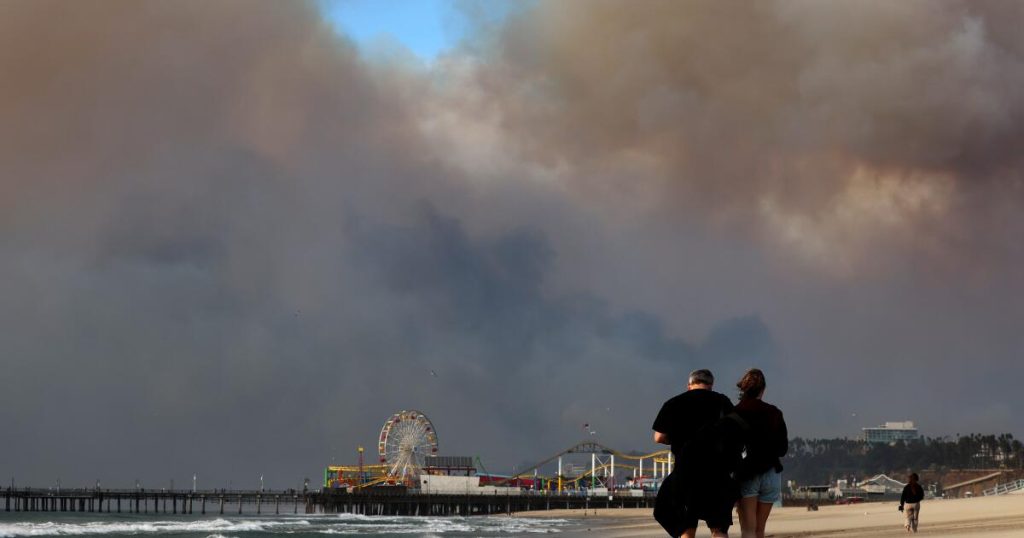
On Tuesday, my niece and I walked to the edge of Venice Pier and watched the bright orange flames creeping into the Santa Monica Mountains in the Pacific Palisades. A thundercloud of smoke loomed over the ocean as fierce winds pushed the smoke offshore and smashed sand into our faces.
On Thursday, I drove to the Palisades with my friend Chris Côté. He owns a modest house near a cliff overlooking the sea. His children grew up there. Now he rents it to a couple with three little girls.
At checkpoints along Sunset Boulevard, police blocked people from entering the devastated community. Only qualified media, emergency vehicles and work trucks were allowed through. Chris and I made it through two lines of police before a stern police officer on Allenford Street refused to let Chris through.
I dropped him off next to Paul Revere Charter Middle School and continued along the curve of Sunset into the Village, the commercial hub of the Pacific Palisades. As you may have seen on the news, this iconic thoroughfare looked like the remains of an incendiary bomb.
The streets were mostly empty except for various official vehicles. Downed power lines and trees littered the road. Several residents surveyed the damage here and there. Teenage boys were riding around town on mini bikes.
What a stark contrast between the fire that swept through the town two days ago and the calm that left in its wake! The fire is a scene of dancing orange flames, flying embers, and swirling heat, smoke, and fear. However, the situation after that is calm and bleak. Adrenaline is replaced by overwhelming sadness, loss, and depression.
The fires, caused by winds reaching 160 miles per hour, were irrational and made senseless choices about what to destroy and what to leave behind. Some buildings and homes remained untouched, as if protected by angel wings. Others simply evaporated into hell.
Once bright and lush, much of the Palisades is now monochromatic, like The Wizard of Oz in reverse. Brick chimneys rise from the rubble, one of the few signs that the streets of this suburban paradise once lined with houses are now hell.
From sunset I turned left onto De La Paz Street and passed several shopping streets. Some areas were still intact, including a veterinary clinic that had been leveled and some built of impermeable brick. I parked on North Beirut Avenue, a three-block street that ends at Via de las Olas, a winding road that runs along the cliffs above the Pacific Coast Highway. The view of Santa Monica Bay from its perch is usually picture-postcard perfect. But on this day, fires were still roaring through the city, fog covered the landscape, and everything was gray.
As I stepped out of the car, a sharp, pungent smell hit me, like a campfire blowing in my face. Ash swirled through the air like toxic snowflakes. A plume of smoke rose from a pile of smoldering, blackened rubble. Utter devastation.
As I write Friday morning, four major fires are still burning across Los Angeles. At least 10 people were killed, an estimated 10,000 buildings were destroyed, and damages amounted to billions. The National Guard was deployed to protect evacuated areas from looters.
Thousands of people, each with their own heartbreaking stories, have been forced to evacuate. Schools are closed. My friend Jean de Ronge, who teaches first grade at the Palisades school that was destroyed by fire, said one of her students, whose family lost their home, was particularly upset about losing a stuffed animal.
The trauma will stay with us for a long time.
This catastrophe will force a civil reckoning that has already begun. There is no more fire season. We have fires all year round. You can call it climate change, or you can pretend it’s something else. It doesn’t matter. The world is getting hotter and weather patterns more extreme, but none of that is good news for California, which oscillates between wet and dry years.
Extreme drought conditions and the strongest Santa Ana winds we have ever seen created this devastation. Fire hydrants ran dry. Firefighters were overwhelmed.
Immediately, political accusations began. Does it really matter that Mayor Karen Bass wasn’t in Los Angeles the day the fire broke out? She’s in constant contact with staff and fire personnel, which, you know, is totally normal in these hyper-connected times. And will it ever make sense that Bass didn’t strip money from the fire department, and that its budget actually increased last year?
President-elect Donald Trump, who never misses an opportunity to criticize Democratic opponent Gavin Newsom, accuses the governor of failing to divert enough water south from Northern California, a comical misunderstanding of the state’s water system. criticized.
All that remains of Chris Côté’s Pacific Palisades home is the chimney.
(Robin Abkyrian/Los Angeles Times)
Conservative cable news pundits have rightly blamed the fire on the city’s diversity, equity, and inclusion (DEI) measures. But the fire department, with its well-paying jobs and very generous retirement benefits, has been under pressure for decades to diversify its overwhelmingly white, male ranks. And rightly so.
For the first time in the city’s history, the city’s fire chief is both female and gay, sending MAGA hordes into a frenzy and foaming at the mouth. At this point, I’ve run out of adjectives for Elon Musk. “DEI means people die,” he wrote on the X Platform on Wednesday.
Meanwhile, in Pacific Palisades, we finally find out which house belongs to our friend Chris. All that remained was the chimney and the iron fence of the balcony.
Driving back to Venice along Chautauqua Boulevard, I saw a young man walking toward the beach carrying a deflated soccer ball he had pulled from the ashes. I could only imagine what he lost.
Blue Sky: @rabcarian.bsky.social.Thread: @rabcarian
Source link




